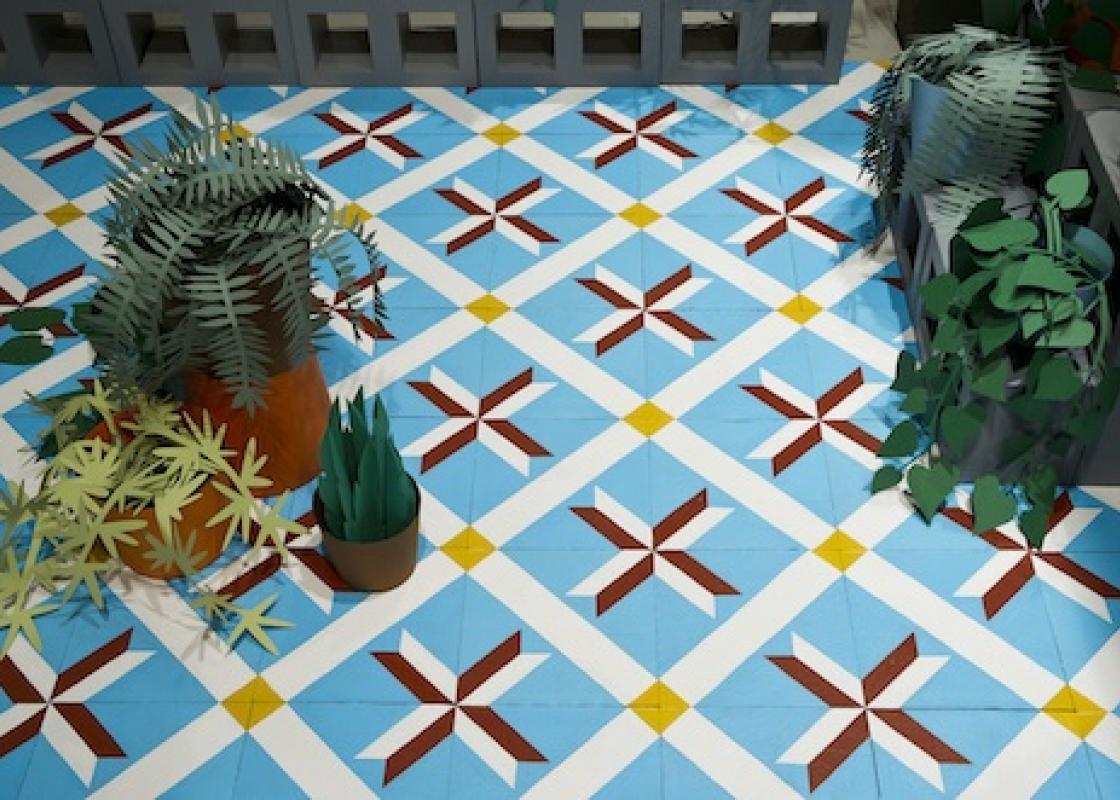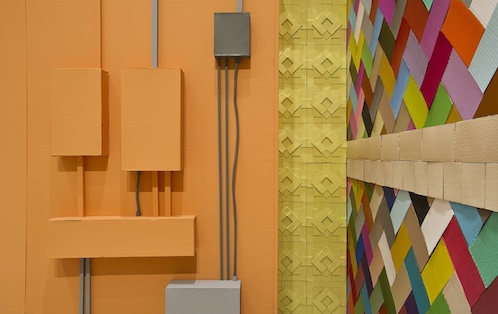
Detail from Ana Serrano's Salon of Beauty, all photos by Nash Baker
"Vibrancy" --- the first and too often the last word that comes up when considering Ana Serrano’s Salon of Beauty, installed at Rice University Art Gallery. The brightly-colored buildings that make up the slightly-smaller-than-life-size cityscape are indeed at first glance “playfully vibrant” as one reviewer writes. The installation, a (re)created blue collar neighborhood from Los Angeles, is comprised of a flower shop, strip club, beauty salon, liquor store, bakery, and the like. Each building is made from wooden frames enclosed in painted cardboard that bring to mind a fantastical, “vibrant,” Disneyland-like aesthetic. It is in this contradiction, between the working class roots of this neighborhood and its aestheticization, that I am interested.
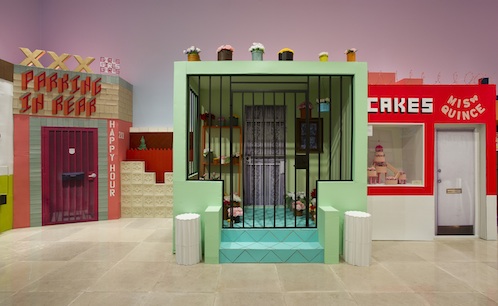
While Serrano shies away from seeing her own work as confronting elements of class division, the work itself seems to address them. But, how are they addressed? Frederic Jameson’s “pastiche” may help to clarify. He writes: “pastiche is, like parody, imitation of a peculiar or unique, idiosyncratic style, the wearing of a linguistic mask, speech in a dead language. But it is a neutral practice of such mimicry [emphasis added], without any of parody's ulterior motives, amputated of the satiric impulse, devoid of laughter.” This, then, may cut to the heart of Serrano’s work. While the work’s “imitation” of a low socioeconomic urban environment may appear to be “neutral,” it produces a tension in the space in which it exists, the space of academia, where collars are white and freshly pressed. But again, we are left with a question: how does this tension function and to what end?
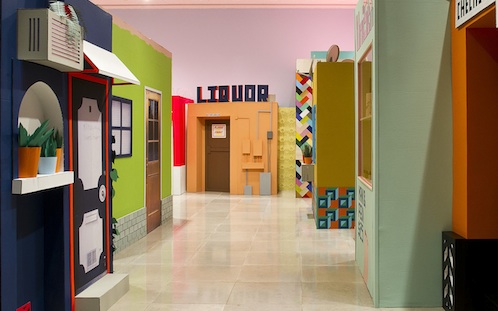
As one, looking for clues, continues to explore the installation, the paradoxical presence and absence of labor in Salon further obscures work of two kinds—that of the artist and that of the inhabitant (who interestingly is absent from the exhibition). The construction of Salon began six months before Serrano came to Houston from Los Angeles and continued on site for another full month. While the size and detail of the buildings that fill the space are impressive, evidence of the artist’s hand is hard to find in the work—as one looks at the leaves of potted plants sitting atop a half-built foundation, for example, their edges are mechanical in appearance. In fact, Serrano notes that while she draws the outlines of the plants by hand, the cutting is done by machines. The hand drawn lines were vectorized in Adobe Illustrator then laser cut at Rice University. This somewhat odd collision of the manual drawing and a technology that all but makes obsolete manual cutting seems to relate to a larger tension in the work, or more specifically, in the represented neighborhood and its relationship to the gallery in which it sits.
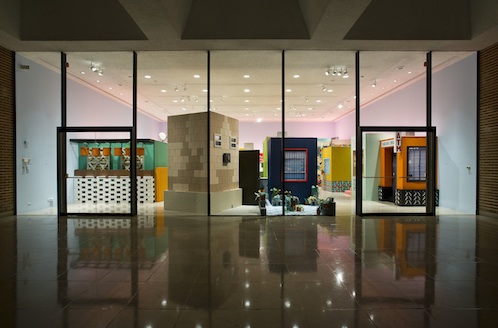
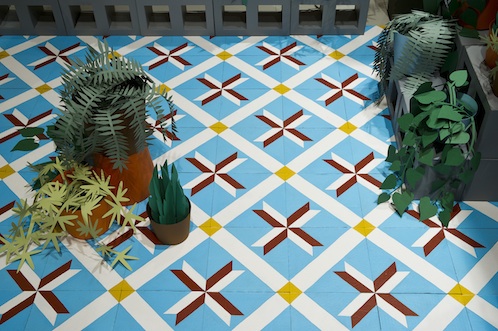
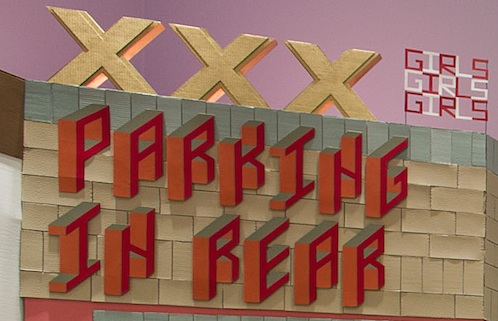
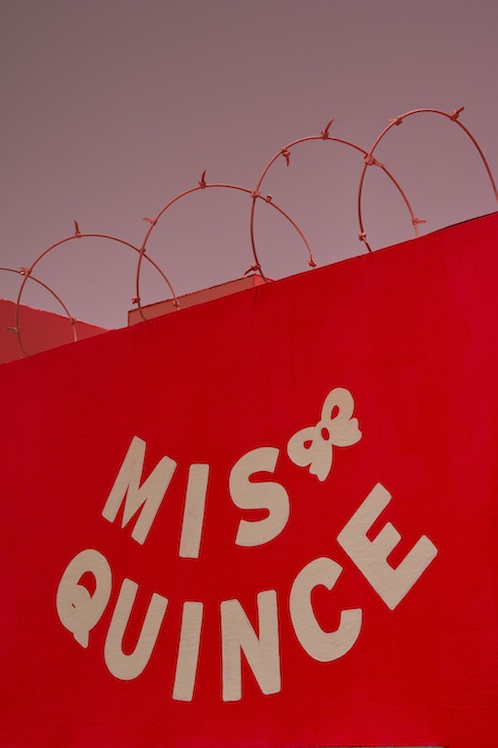
Although viewers indeed physically enter the space of this constructed working class Los Angeles block, they remain both within Rice University and outside of Los Angeles and any working class neighborhood. The installation sits behind a glass wall exposed to passersby, who, if they choose to do so, may enter the space and look around. It is this tension that I find to be so provocative in the work. It reproduces certain tropes of the neighborhood that it stands for, including barbed wire made from plastic zip ties, security bars over windows and doors, and a series of dissimilar businesses that juxtapose one another in interesting ways. So, there is a kind of layering of tension in the work, one internal between these buildings and a second at a more macro level between the working class neighborhood and the University setting. Perhaps, it is within these juxtapositions that Serrano’s work resists slipping into Jamesons’ “pastiche,” and instead disrupts the kind of carefree enjoyment of the vibrantly colored Disneyland ride.
Further Reading
Aaren Pastor, “Salon of Beauty opens in Rice Art Gallery” The Rice Thresher (September 30, 2011), accessed October 10, 2011.
Douglas Britt, “Installation brings an urban flavor to Rice Gallery,” Chron.com (September 27, 2011), accessed October 10, 2011
Tyler Rudick’s “A guide to Museum District Day for all types: From hardcore art lovers to science buffs to parents with curious kids” Culture Map Houston (September 16, 2011)
“Cardboard cityscape an artful endeavor at Rice Gallery” Your West U News online (September 27, 2011), accessed October 10, 2011. See ricegallery.org for information on Serrano’s installation and links to these and other reviews of her work.
Fredric Jameson. Postmodernism, or, The Cultural Logic of Late Capitalism (Durham, NC: Duke University Press, 1991) 17.
About the writer:
Philip Kelleher is a Core Fellow in Critical Studies at the Glassell School of Art.


